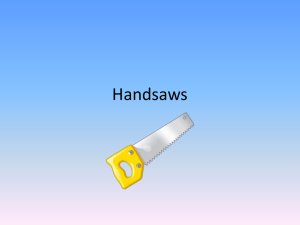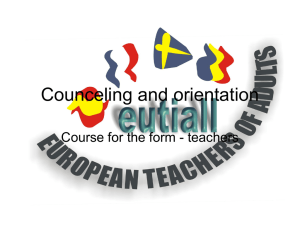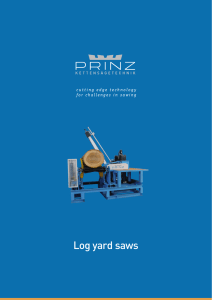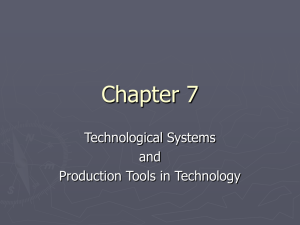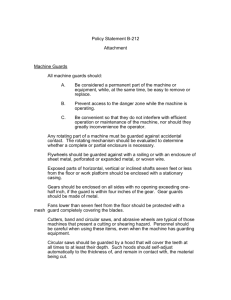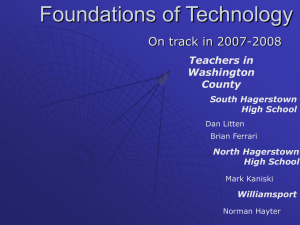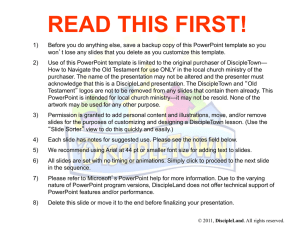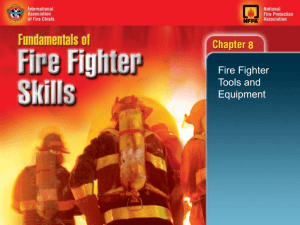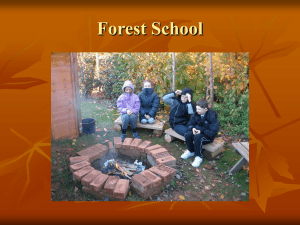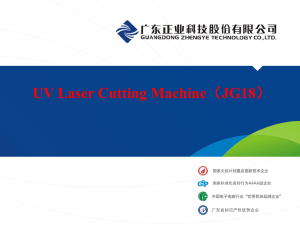Chapter 7 - Washington County Public Schools
advertisement
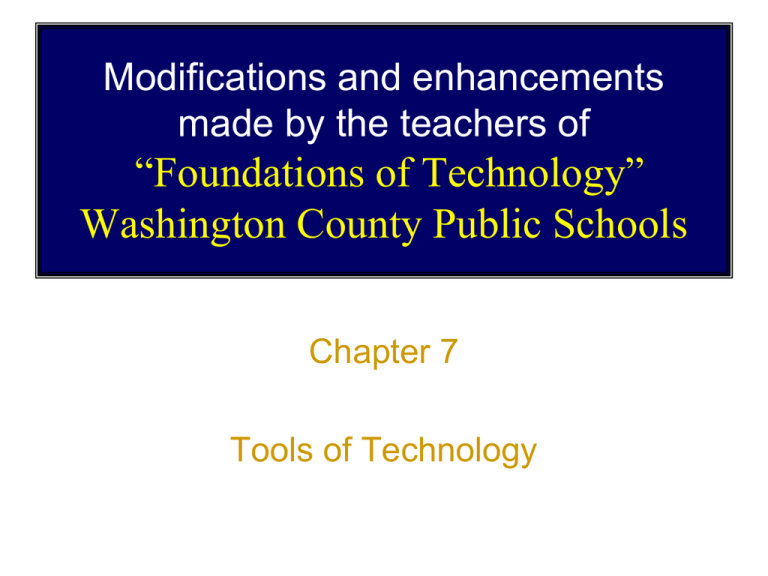
Modifications and enhancements made by the teachers of “Foundations of Technology” Washington County Public Schools Chapter 7 Tools of Technology Most PowerPoint's include in the following order: • Suggestions - suggestive engagement activities / project for the chapter • Voluntary State Curriculum objectives met within this chapter and pages of the book that correlate to these objectives. • The long term objective for the course. The short term objective “Big Idea” for this chapter. Qualifier for learning the stated objectives. • Lesson Procedures • Warm Up – Timed Daily Reading – Timed Objectives to be written • Introduction of an Academy or CTE Program • Lesson (to include learner engaging activities) – Higher Order questioning – Timed group activities • Place where you can work in Washington County with the skills learned in this chapter • Review of Career • Closure (exit ticket) – Review of Objectives – Homework Assignment – Study foundationsoftechnology.com Suggestions • See document on teacher website • Contact Lee Rurack Voluntary State Curriculum Chapter 7 VSC Term Pages in Text Book 1.A.4 Explain that technology liberates us from demeaning and demanding labor and, therefore, creates more leisure. 1.C Develop an understanding of the relationship among technologies and the connections between technology and other fields of study. 148 2.D.2 Defend the proposition that the evolution of civilization has been directly affected by, and has been in turn affected, the development and use of tools and materials 127-139 2.D.4 Analyze the development and use of technology in the preagricultural, industrial, and information ages. 146 2.D.4 Analyze the development and use of technology in the preagricultural, industrial, and information ages. 134 140-148 2.E Develop an understanding of the influence of technology on history. 2.E.1 Analyze how different cultures develop their own technologies to satisfy their individual and shared needs, wants and values. 127-139 127-148 146 Voluntary State Curriculum Chapter 7 VSC Term Pages in Text Book 2.E.1 Analyze how different cultures develop their own technologies to satisfy their individual and shared needs, wants and values. 2.E.3 Explain that the evolution of civilization has been directly affected by, and has in turn affected the development of tools and materials. 2.E.7 Explain that the Middle Ages saw the development of many technological devices that produced long-lasting effects on technology and society. 146 2.E.9 Explain that the industrial Revolution saw the development of continuous manufacturing, sophisticated transportation and communication systems, advanced construction practices, and improved education and leisure time. 134 140-148 3.B.6 Explain constraints on the engineering design process. At Least: Safety, Reliability, Economic Considerations, Quality Control, Environmental Concerns, Manufacturability, Maintenance, Human Factors Engineering (Ergonomics) 151-153 3.D Select and use tools and equipment correctly and safely 151-153 3.D.2 Select and use tools based on the properties of materials 127-139 134 140-148 127-139 Voluntary State Curriculum Chapter 7 VSC Term Pages in Text Book 3.F Develop abilities to use and maintain technological products and systems 3.F.3 Operate systems so that they function in a way they were designed 3.F.4 Troubleshoot, analyze and maintain systems to ensure safe and proper function and precision 4.E.1 Identify and describe applications of electrical technology in the designed world. Such as: Generators, Electric motors, Alarm systems, Automobile electrical systems 144 145 4.E.4 Analyze the magnetic effects of current (i.e., electromagnet) and the electric effects of magnets (i.e., motors). 144 4.F.1 Identify an describe applications of electronic technology in the designed world. Such as: computers, Telephones, Radio and television 145-151 5.D Develop an understanding of energy and power technologies. 139-145 5.D.1 Explain that energy cannot be created nor destroyed; however, it can be converted from one form to another. 139-145 All 151-155 All Voluntary State Curriculum Chapter 7 VSC Term Pages in Text Book 5.E Develop an understanding of information and communication technologies 145-151 5.E.1 Explain that information and communication systems include inputs, processes, and outputs associates with sending and receiving information. 145-151 5.F Develop an understanding of transportation technologies 465 5.G Develop an understanding of manufacturing technologies 134 5.G.6 Classify manufacturing systems as being customized production, batch production, or continuous production. 134 Objectives • Over Arching (Long Term) Objective (s) … – The students will develop a basic understanding of the design world. – How would an improved technical awareness improve one’s life? • This chapters “Essential Question, Big Idea” – The use of tools has improved our society in what ways? • Students will be able to answer the daily objectives within this PowerPoint to a 70% degree of efficiency. Technology Resources Teacher Computer, Projector, White board, Student Computers, Name Randomizer, Timer, www.foundationsoftechnology.com, .foundationsoftechnology.com/worldsbestfotteachersareinwcps Materials Handouts, Project Materials Lesson Plan Instructional Procedures and Content Notes Silent Reading (7 minutes) – Slide is automatically timed Write Objectives (5 minutes) – Students write daily objectives in their notebooks. Leaving enough room to write the answers to the objectives at the end of class / Slide is automatically timed (Song may play to tie into the objectives) Chapter PowerPoint (35 minutes, approximately can go much longer or shorter) Teacher conducts interactive lecture with a PowerPoint slideshow while students take fast notes and participate in higher order questioning, and small group activities. PowerPoint also includes short video clips & web links. Desk Activity (10 minutes, Approximately) Vocabulary Students write each word multiple times and define each word. Test Your Knowledge Students answer designated summary questions for the chapter. Study with the FoundationsofTechnology.com website Projects / Computer Activity (28 minutes Approximately) Closure (Review of 5 minutes, Objectives Approximately) Homework: (if applicable) Finish Vocabulary / Objectives / Test Your Knowledge Study with the FoundationsofTechnology.com website Modifications to meet student needs (IEP, ILP, ELL and Special Needs) Students with writing difficulties may write the objectives later. Slower students will be accommodated by being given the complete set of notes and ask to underline the key words other students are writing down. Slide shows are equipped to click on voice over buttons (created by advanced students,) so the slide show can be read to those who need it on an individual basis. Modifications to meet student needs (Enrichment) Advanced students improve the PowerPoint lectures for various chapters. They add voice over, modify pictures, find movie clips, website links, etc, and can chose from a list of independent project challenges. Sources: Include electronic and printed materials as well as acknowledgement of any influence or guidance provided in the development of the lesson: Wright, R. Thomas. (2008). Technology. Illinois: The Goodheart-Willcox Company, Inc. PowerPoint Presentations for Technology By R. Thomas Wright The Goodheart-Willcox Company, Inc. Tinley Park, Illinois www.g-w.com Chapter 7 Day 1 Read Pages 126 - 139 Tools of Technology Copy the following Big Idea “The use of tools has improved our society in what ways?” & Objectives 1. What are the categories of production tools used in technology? 2. What are the common characteristics of machine tools? 3. What are the six major types of machine tools? Learning Objectives 1. What are the categories of production tools used in technology? 2. What are the common characteristics of machine tools? 3. What are the six major types of machine tools? Section 3 Chapter 7 Tools of Technology Day 2 Read Pages 126 - 139 Learning Objectives 4. What are three types of processing discussed in this chapter? 5. Name three types of informationprocessing tools or machines.. 6. Name a few basic guidelines for safely operating technological devices. Learning Objectives 4. What are three types of processing discussed in this chapter? 5. Name three types of informationprocessing tools or machines.. 6. Name a few basic guidelines for safely operating technological devices. Day 1 Production Tools Used in FOT Processing The human ability to design and use tools provides the foundation for technology. Three major types of processing: Material processing. For example, changing lumber into plywood. Energy processing. Changing flowing water into hydroelectricity. Information processing. Telecommunications, printing, and the computer. Machine Tools The world around us is full of artifacts made through material-processing. Fundamental to all material-processing is a group of tools called machine tools. Machine tools have some common characteristics like a cutting tool, a method of moving the tool or workpiece, and a method of supporting the tool and the workpiece. The Cutting Tool Share common requirements shown in image to right. Two basic types: singlepoint tool or multiplepoint tool. Single-point tools: hand tools, lathe-turning tools. Multiple-point tools: abrasive papers, grinding wheels. Motion All cutting operations have two basic motions: cutting motion and feed motion. Three cutting motions: Rotating motion. Linear motion. Reciprocating motion. Support The types of cutting and feed motions used determine the support system needed. Different parts such as chucks, arbors, clamps, and machine tables can be used to provide support. Most parts support different movements and can be combined in different ways, depending on what support is needed. Types of Machine Tools Hundreds of different machine tools exist. All machine tools can be grouped into six categories, however. Turning Machines Turning machines use a process in which a workpiece is held and rotated on an axis. Lathes, a form of turning machines, are used primarily to machine wood and metal. All lathes contain four main parts: headstock, tailstock, bed, and tool rest or holder. Lathes are used to perform turning, tapering, facing, grooving, chamfering, parting, threading, and knurling. Sawing Machines Sawing machines are designed to perform a number of different cutting actions, as shown in the image. The machines can be grouped into three basic types of saws: circular saws, band saws, and scroll saws. Circular Saws Blade in the shape of a disk with teeth around the edge. Used for crosscutting, ripping, and combination cutting. Three basic types: table saw, radial saw, and chop saw. Band and Scroll Saws Band saws use a blade with teeth on one or both sides. The band may be either vertical or horizontal and may be held by vises and clamps or placed on a table. Scroll saws have teeth on just one edge of the blade and can also be either vertical or horizontal. They are supported primarily by a table. Drilling Machines Cylindrical holes are common in parts and products. They can be produced by various drilling machines. Drilling machines can perform various operations through a few different machines like: twist drills, spade bits, and forstner bits. Drilling Machine Operations Drilling, counterboring, countersinking, and reaming are common drilling operations. Shaping and Planing Machines Both shaping and planing machines: Use single-point tools to produce flat surfaces on metal parts and products. Can cut on the face or side of a part. Can machine grooves into the surface. Are closely related to a broach. Shaping and Planing Machines Shaping and planing machines move in opposite motions to produce similar effects. Grinding Machines Grinding machines use bonded abrasives to cut material. The two most common are the cylindrical and surface grinders. The pedestal grinder is also used and is a manually run machine. Class Work Answer Objectives # 1-3 Test Your Knowledge - Page 154 - # 1 - 6 Work on projects Three Students to Answer Objectives Timer Homework - Vocabulary & Unfinished Work Review What are the categories of production tools used in technology? Material processing Energy processing Information processing Review What are the common characteristics of machine tools? Method of cutting, series of motions, and support of the tool and workpiece. Review What are the six major types of machine tools? 1. 2. 3. 4. 5. 6. Turning Sawing Drilling Shaping Planing Grinding Day 2 Energy-Processing Converters Energy conversion takes place through energy-processing converters. There are hundreds of energy-processing converters. For example: changing mechanical energy into electrical energy through an electric generator. Three converters, the steam engine, the electric motor, and the internal combustion engine have had a big impact on technology. The Early Steam Engine The Watt Steam Engine Reciprocating steam engine. Used for industrial machines and transportation vehicles. Discussion Why might steam engines not be as commonly used today? Internal Combustion Engine Each stroke combined in a four-stroke engine completes a cycle. The Electric Motor Laws of magnetism and electromagnetism: Like magnets repel one another, unlike poles attract. Current flowing in wire creates electromagnetic field. The field magnet and armature are major parts of an electric motor. Information-Processing Machines Information processing includes: Printing. Telecommunications. Telephone. Radio. Computers. The Telephone and Radio The telephone converts sound into electrical energy. Use has been expanded from personal communication device to a data-transmission instrument. The radio uses radio waves that travel through the atmosphere and space. Used to carry information and entertainment. Computers Using Technology Safely In order to use technology safely: Use the correct tools. Remember proper operation. Seek advice as needed. Use only as directed. Never use when personal ability is impaired. Never work alone in case of an accident. Safety with People Personal safety: Concentrate on your work. Dress properly to protect yourself. Think before acting. Ask questions when you are unsure. Safety around others: Avoid horseplay. Do not talk with anyone operating machinery. Do not misplace tools. Safety with Materials Handle materials properly and with care. Check all materials for sharp burred edges and pointed ends. Place materials in well-ventilated areas, when necessary. Lift material properly. Clean up and dispose of spills and materials properly. Safety with Tools and Machines Use only sharp tools and well-maintained machines. Return all tools and machines to proper places. Use the correct tools and machines for the correct job. Do not use any tool or machine without permission or proper instruction. Career Corner Machinists. Interpret blueprints, set up machines, and produce precision parts. Most are trained through apprenticeship programs, on-the-job training, vocational schools, or community colleges. International Association of Machinists Class Work Answer Objectives # 4-6 Test Your Knowledge - Page 154 - # 7-15 Work on projects Three Students to Answer Objectives Timer Homework - Vocabulary & Unfinished Work Review What are three types of processing discussed in this chapter? 1. Material 2. Energy 3. Information processing. Review Name three types of information-processing tools or machines. 1.The telephone 2. Radio 3. Computer. Review Name a few basic guidelines for safely operating technological devices. Use the correct tools; remember proper operation; seek advice as needed; use only as directed; never use when personal ability is impaired; never work alone in case of an accident.
